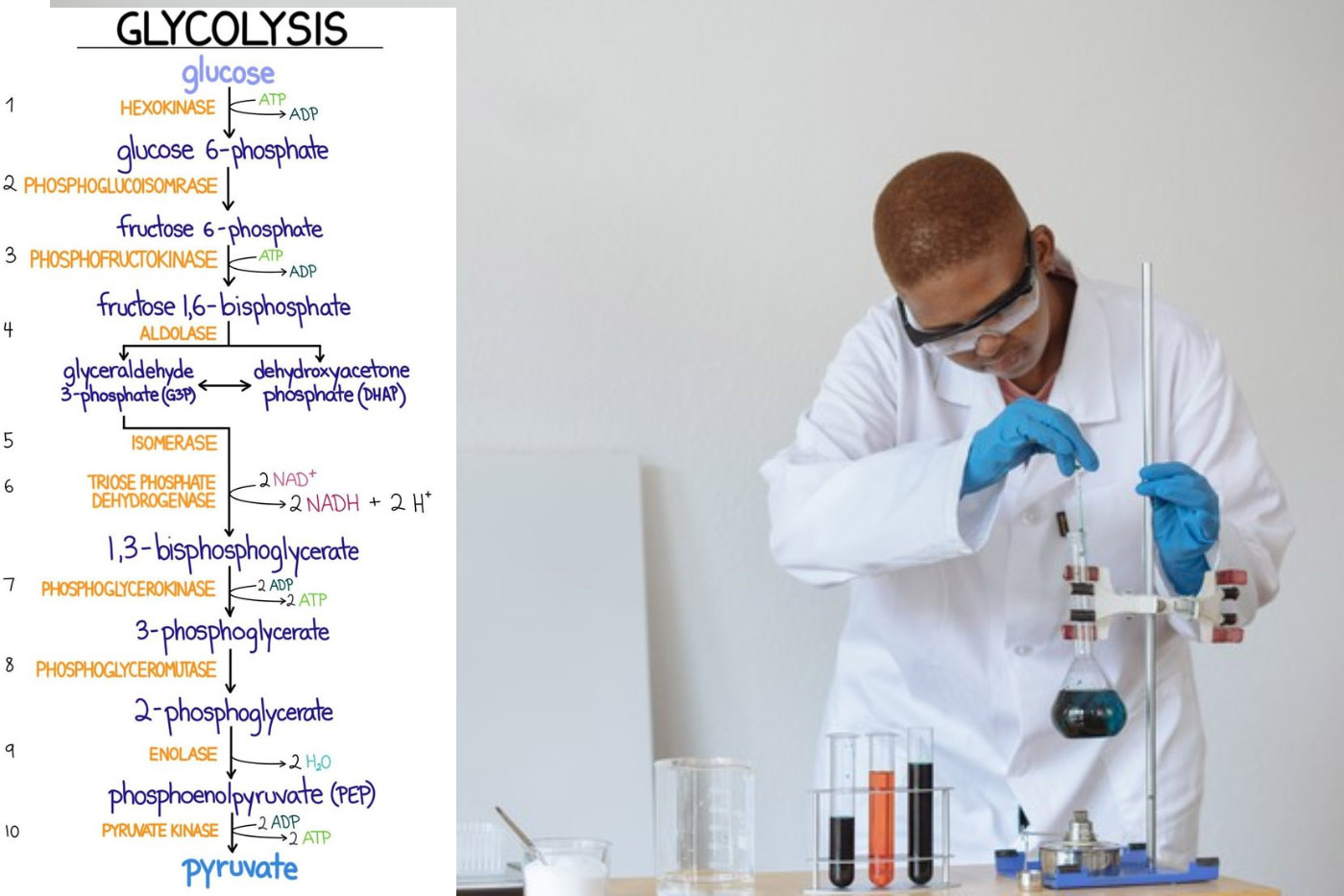Glycolysis is a fundamental metabolic pathway that is crucial for energy production in cells. It involves the breakdown of glucose (a six-carbon sugar) into pyruvate (a three-carbon compound), yielding energy in the form of ATP and NADH. This pathway is highly conserved across different species, underscoring its importance in cellular metabolism.
Glycolysis consists of ten steps, which can be broadly divided into two phases: the investment phase and the payoff phase.
- Investment Phase: This phase uses energy to modify glucose into two three-carbon molecules.
- Step 1: Hexokinase phosphorylates glucose to form glucose-6-phosphate.
- Step 2: Glucose-6-phosphate isomerizes to fructose-6-phosphate via phosphoglucoisomerase.
- Step 3: Phosphofructokinase adds another phosphate to form fructose-1,6-bisphosphate.
- Step 4: Aldolase cleaves fructose-1,6-bisphosphate into glyceraldehyde-3-phosphate and dihydroxyacetone phosphate.
- Step 5: Triose phosphate isomerase converts dihydroxyacetone phosphate into glyceraldehyde-3-phosphate.
- Payoff Phase: This phase generates ATP and NADH by oxidizing the three-carbon molecules.
- Step 6: Glyceraldehyde-3-phosphate dehydrogenase converts glyceraldehyde-3-phosphate into 1,3-bisphosphoglycerate, producing NADH.
- Step 7: Phosphoglycerate kinase transfers a phosphate from 1,3-bisphosphoglycerate to ADP, forming ATP and 3-phosphoglycerate.
- Step 8: Phosphoglycerate mutase converts 3-phosphoglycerate into 2-phosphoglycerate.
- Step 9: Enolase dehydrates 2-phosphoglycerate to phosphoenolpyruvate (PEP).
- Step 10: Pyruvate kinase transfers a phosphate from PEP to ADP, producing ATP and pyruvate.
Importance of Glycolysis Pathway
Glycolysis is the first step in cellular respiration, functioning both in the presence and absence of oxygen. In aerobic conditions, pyruvate enters the citric acid cycle for further energy production. Under anaerobic conditions, cells can convert pyruvate into lactate or ethanol, depending on the organism.
This pathway is not only essential for energy production but also for providing intermediates for other metabolic processes. Understanding glycolysis is crucial for biochemists as it lays the foundation for studying more complex metabolic pathways and their regulation.
Regulation of Glycolysis
The glycolysis pathway is tightly regulated to ensure efficient energy production and to meet the cell’s metabolic needs. Several key enzymes act as regulatory checkpoints:
- Hexokinase/Glucokinase: These enzymes catalyze the first step in glycolysis. Hexokinase is inhibited by its product, glucose-6-phosphate, preventing the excessive accumulation of glucose-6-phosphate when glucose is abundant. Glucokinase, present in the liver, has a higher Km and is not inhibited by glucose-6-phosphate, allowing the liver to handle high glucose concentrations.
- Phosphofructokinase-1 (PFK-1): This enzyme catalyzes the rate-limiting step of glycolysis. It is allosterically inhibited by ATP and citrate, indicating a sufficient energy supply, and is activated by AMP and fructose-2,6-bisphosphate, which signal a need for more ATP.
- Pyruvate Kinase: The final step of glycolysis is regulated by pyruvate kinase. It is activated by fructose-1,6-bisphosphate (feed-forward activation) and inhibited by ATP and alanine, indicating adequate energy levels.
Clinical Relevance
Defects in glycolytic enzymes can lead to various metabolic disorders. For example, pyruvate kinase deficiency is a common cause of hemolytic anemia, where red blood cells break down faster than they are produced. This condition highlights the crucial role of glycolysis in cells that rely heavily on this pathway for energy production, such as red blood cells.
Additionally, cancer cells often exhibit increased glycolysis rates, known as the Warburg effect. This phenomenon is utilized in cancer diagnosis and treatment, as rapidly proliferating tumor cells preferentially metabolize glucose through glycolysis even in the presence of oxygen.
Advanced Applications
Understanding glycolysis is essential for various applications in biotechnology and medicine. For instance:
- Metabolic Engineering: Glycolysis can be manipulated to enhance the production of biofuels and biochemicals. By modifying certain enzymes, scientists can redirect metabolic fluxes to increase yields of desired products.
- Drug Development: Targeting glycolytic enzymes offers therapeutic potential for treating diseases like cancer and diabetes. Inhibitors of glycolytic enzymes are being explored to starve cancer cells of energy.
- Clinical Diagnostics: Measuring glycolytic intermediates and enzyme activities can aid in diagnosing metabolic disorders. For example, elevated lactate levels can indicate hypoxia or mitochondrial dysfunction.
Glycolysis is a cornerstone of cellular metabolism, providing energy and metabolic intermediates. Its regulation is complex and critical for maintaining cellular homeostasis. Understanding the intricacies of this pathway offers insights into normal cellular function and disease states, highlighting its importance in biochemistry and medicine.
For a deeper dive into the details of glycolysis and its steps, refer to resources such as Biology Dictionary, Microbiology Info, and Leah4Sci, which offer detailed explanations and diagrams (Microbiology Info.com) (Biology Dictionary) (MCAT & Org Chem Study Guides).








Comment